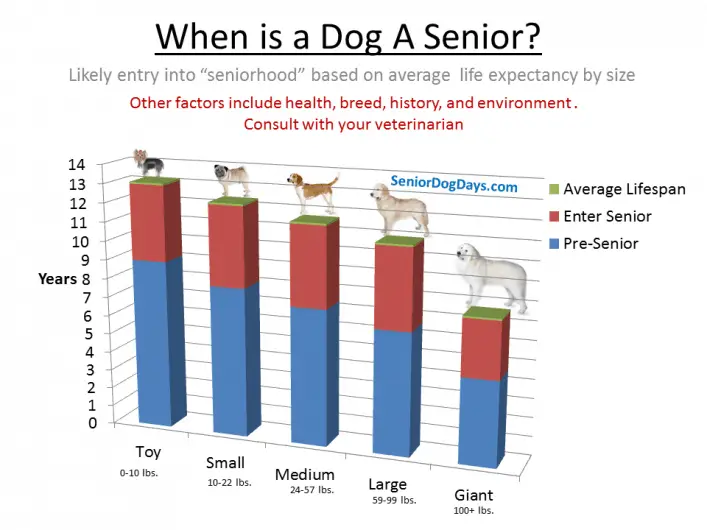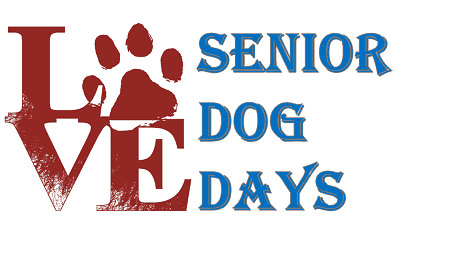Some content may contain affiliate links to products which means we could earn a fee on your purchase. Thank you for visiting
Whether you’re noticing a general change in your dog’s behavior or someone in passing innocently refers to your dog as a ‘good ol’ boy’ or ‘beautiful old girl,’ something has got you wondering:
“what is considered old for a dog and is my dog a senior?”
This article and the dog ageing chart (or aging if you prefer) will help you understand how old your dog really is and how quickly your dog is moving through her life and what you can do to make her as comfortable as possible through each life stage.
If you want to skip the background information and get to the point of finding out what is considered old for a dog, you can check out the below dog ageing chart and use it as a benchmark.

But for a more thorough understanding of your dog’s current life stage, please continue reading…because the old 7-year rule is out!
The Shift from Dog Years to Dog Life Stages
Obviously, the most accurate assessment of your dog’s life stage will come from conversations and visits between you, your dog, and your dog’s veterinarian. Like it or not, our dog’s overall health has a huge impact on their ‘real age’. So next time you’re with your veterinarian, talk about your dog’s life stage and find out what you could do to make life better or easier for him.
In the meantime, the old 7-year rule Article (multiply your dog’s age by 7) is outdated. Instead of trying to convert dog years to human years, it is far more helpful to our dogs if we take the time to understand the stages of their comparatively short, beautiful lives.
Why We Don’t Know if Our Dog is Old
We humans did a great job creating age categories for our own species and everyone fits into their place relatively well. For instance, we can all reasonably agree that humans will progress through these aging labels at a specified age:
- Babies and infants 0-2 years
- Toddlers 2-4
- Childhood-5-11
- Adolescent 12-19
- Adulthood 20’s-30’s
- Middle Age 40’s- 50’s
- Senior – 65
- Elderly – 75
While sorting human beings by age has its pitfalls, it also comes with some tremendous benefits, especially when it comes to keeping us safe and healthy.
For instance, we are told that around age 40; women should have a mammogram and men, a prostate exam. Seniors are given preferred status when it comes to flu vaccines etc.
Well it’s only natural that as we begin to think about our dog’s health, we try to sort our 4-legged friends the same way.
It would be really easy if we knew “at 4 years old, we give our dog more calcium” “at 5 years it’s his first body x-ray, etc.. But that’s not how it works with dogs because they are have entirely different needs based on their breed…not their numerical age.
So, dogs do not fit neatly into our human methods of categorizing by age.
So How Do We Categorize Dogs?
Well, for starters, we don’t need the same 8 categories we use to sort humans. Because our dogs have a much lower life expectancy than us, we can start by reducing dog age categories to just 3 simple stages:
- Young Dog
- Adult Dog
- Senior Dog
Secondly, using the 3 categories, we will chart their life stage based on their size – as opposed to just using their age.
When it comes to breed size, the following weights are commonly used as weight guidelines:
- Toy or Small dog breeds – 0-10 to and 10-22 pounds
- Medium dog breeds – 24 to 57 pounds (11-26 kg)
- Large dog breeds – 59 to 98 pounds (27-44 kg)
- Giant dog breeds – 99 pounds or more (45 kg+)
Now that we have their breed size we can estimate how far into their lifespan our senior dog is by researching the average lifespan based on breed size.
It’s worth mentioning that breed, family history, diet and lifestyle contribute greatly to your dog’s life expectancy and these are simply national averages.
Also note that your dog could fall in between two sizes. For example my mixed breed dog is considered “extra large.” One of his veterinarians says he’s a large breed and another classifies him as giant breed.
Let’s review some common problems that occur with our senior dogs that are a direct result of their size, and what we can do to help them along the way.
Breed Size Examples and Common Problems
Small Sized Dog Breed examples including Toy, Teacup: Poodles, Yorkies, Maltese, Chihuahua, Pug, etc.. Because it’s so easy to pick these little guys up it’s very common for our small breed dogs to become overweight and achy due to lack of exercise.
And even though you CAN carry them around, it doesn’t mean you should ignore supplements and activities that will improve their mobility.
Make a concerted effort to let these little guys walk around to keep the circulation going as long as they are able.
Medium Sized Dog Examples: Border Collies, Corgies, certain Terriers, Bulldogs, Shelties. Etc., A lot of medium sized dogs are full of energy and do a lot of running, jumping, herding, up and down stairs, running fence lines, etc.
Because they are so active, visible signs of aging are not always apparent. Owners of medium sized senior dogs can be blindsided by the news of a serious illness because everything seemed normal.
Regular vet visits, regular blood panels and performing your own thorough body inspections can help catch issues early in these troopers!
Large Sized Dog Breed Examples: Labs, Dobermans, Retrievers, Rotties, Greyhounds, Collies etc., Large dogs usually have high exercise requirements, and are best suited to homes with plenty of space, such as a large outdoor yard. Large dogs are more likely to show visible signs of aging, but you can’t count on it. Good vet’s will mention supplementation early. Their adulthood diets should take into account the need for bone and joint health.
Giant Sized Dog Breed Examples: Wolfhounds, Newfoundland, Great Danes, Bullmastiffs. Our giant friends usually grow rapidly during the first 6 months of their life and are prone to digestive issues.
They usually attain adult-size by the time they’re 2 years old and then move rapidly through their life stages. If you think your 6 year old Great Dane is young…you’d be very wrong.
The giant breeds have a lot of weight to support and cannot be carried around when they become arthritic, which they are extremely prone.
Starting a vet-approved, joint supplement regimen as soon as they are adults will give them the best odds for living pain free in their senior years.
If you have no idea what breed your dog is and you’ve ever wondered if a DNA test would be worth the trouble, I’ve shared my experience and why I recommend a DNA test. You can read it here: Is a Dog DNA Test Worth It? and I show you the exact test results of my senior dog and how it changed my approach.
So You Found Out Your Dog’s a Senior…Now What?
Even if you’ve just discovered that your best friend turned into a Senior Dog last year, it doesn’t mean it’s too late to address the things that will slowly impact his comfort and mobility.
Starting them on a joint supplement regimen right now can still pay huge dividends as they travel through their senior stage of life.
My dog Frodo 12 and has been a senior dog now for 6 years. He’s had hypothyroidism since he was 6 years old and has been dealing with arthritis in the spine and hips for the last 3 years.
My vets agree that he is in between a giant breed and a large breed. His youth ideal weight was right at 100 lbs. and now he hovers around 90 lbs.
We started him on a joint supplement regimen at the age of 5 or 6 (MSM and Glucosamine with Chondroitin) and are so grateful to our vet for recommending this.
Although he is still very mobile at 12, we started to notice a new and persistent “get up limp”, and his arthritis seemed more noticeable on our walks. You could actually see his back paw turn over, as though he were walking on the exterior portion.
Over the past 3 months, we’ve taken a staggered approach and implemented the following 3 new items.
- Now Brand Glucosamine, Chondroitin, MSM (morning pills)
- Movoflex (evening chew)
- Adequan (series injection-requires prescription)
Each supplement, individually and together has made a huge difference in his ability to go from a sitting to standing position and we noticed results after 1 week. You can read our extensive product reviews here: Arthritis Supplement Reviews for Dogs (the good and bad).
and we also have a comprehensive (20 things) guide for what we do to treat a dog’s arthritis at home.
It is not too late to see results!
The Benefits of Knowing Your Dog’s Life Stages
Not every dog will have obvious signs of pain or mobility issues. By the time we might be visually alerted to some typical signs of aging, our pups could be well into their glory years, AKA: a Senior Dog.
Knowing whether your dog is an adult vs. knowing they are a senior will help ensure that you and your best friend get to share a long, healthy, comfortable life together.
And while translating your dog’s exact age no longer happens with a calculator, you’ll be able to do it just fine now that you’ve learned to apply canine practicalities rather than human factors.
As you can see from the dog ageing chart, a dog’s age does not fit into human categories. They move through their stages at different paces based on their size and you can help them stay healthy and comfortable.
Thanks for visiting SeniorDogDays!

